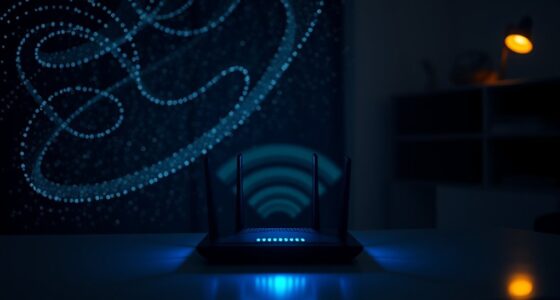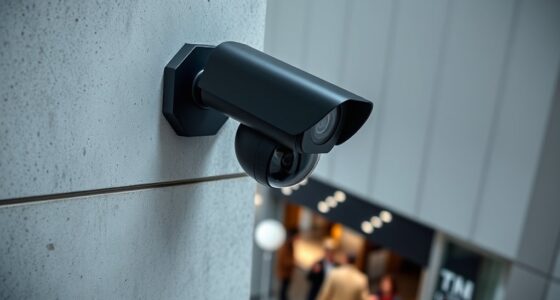Everyday devices are becoming smart through the Internet of Things (IoT), connecting your gadgets for better communication and efficiency. Wearables like fitness trackers and smartwatches keep you informed about your health, while smart home devices let you control temperature and lighting easily. These technologies learn your habits to streamline your daily routines. With each innovation, your environment becomes more connected and seamless. Discover how these advancements shape your life and what’s coming next.
Key Takeaways
- The Internet of Things connects devices, enabling them to communicate and share data for smarter functionality in daily life.
- Wearable technology, like fitness trackers, monitors health metrics and provides real-time feedback to promote healthier habits.
- Smart home devices, such as thermostats and voice assistants, enhance convenience by allowing remote control of home systems and automating tasks.
- Integration of devices creates a connected environment that anticipates user needs and personalizes experiences through automation.
- IoT applications extend beyond health and home, innovating everyday appliances like espresso machines for precise and convenient usage.

Have you ever wondered how everyday objects are becoming smarter? It’s fascinating to see how technology has evolved to make our lives easier, and it all comes down to the Internet of Things (IoT). This technology connects devices to the internet, allowing them to communicate and share data, which transforms simple tools into intelligent systems that can enhance your daily routine. Whether it’s wearable technology or smart home devices, these innovations are designed to improve efficiency and convenience in your life.
Everyday objects are evolving into smarter tools through the Internet of Things, enhancing our efficiency and convenience.
Take wearable technology, for example. Fitness trackers and smartwatches have changed how you monitor your health. With just a glance at your wrist, you can track your heart rate, count your steps, and even receive notifications from your phone. These devices gather data about your activity levels and sleep patterns, helping you make informed decisions about your health. You might find yourself motivated to exercise more or sleep better because of the real-time feedback these wearables provide. It’s not just about style; it’s about creating a healthier lifestyle.
Then, think about smart home devices. From smart thermostats to voice-activated assistants, these gadgets are revolutionizing how you interact with your living space. You can control your home’s temperature from your phone, adjust the lighting with a simple command, or even ensure your front door is locked without getting up from the couch. These devices learn your habits and preferences, making daily tasks more seamless. Imagine coming home to a house that’s already set to your ideal temperature, with your favorite playlist playing in the background. That’s the power of smart home technology.
The integration of wearable technology and smart home devices not only simplifies your life but also contributes to a more connected world. As your devices communicate with one another, they create a network that anticipates your needs. For instance, your wearable might detect that you’re nearing your daily activity goal and send a signal to your smart home devices to play upbeat music to encourage you to move more.
Ultimately, the Internet of Things is reshaping how you interact with the world around you. By embracing these innovations, you’re not just keeping up with the latest trends; you’re actively enhancing your life. So, whether you’re monitoring your health with a fitness tracker or controlling your home environment with smart devices, you’re participating in a smarter future. Moreover, the rise of Italian espresso machines demonstrates how IoT is expanding into culinary experiences, allowing coffee enthusiasts to brew the perfect cup with precision and convenience.
Frequently Asked Questions
How Secure Are Smart Devices From Hacking?
Smart devices can be vulnerable to hacking, but their security largely depends on features like device encryption and hacking prevention measures. You should always check if your devices support strong encryption to protect your data. Regularly updating firmware and using unique passwords can further enhance security. While no device is completely immune to threats, being proactive can substantially lower the risk of your smart devices being hacked. Stay informed and vigilant!
What Are the Environmental Impacts of Iot Devices?
The environmental impacts of IoT devices are nothing short of monumental. You’ll find that their energy consumption can skyrocket, especially with numerous devices constantly connected. Additionally, as technology evolves, electronic waste becomes a pressing issue, with many outdated gadgets ending up in landfills. By being mindful of your device usage and opting for energy-efficient models, you can help mitigate these effects and contribute to a more sustainable future.
Can Iot Devices Work Without Internet Access?
Yes, IoT devices can work without internet access, but their capabilities may be limited. Many devices offer offline functionality, allowing you to control them locally through a direct connection, like Bluetooth or a local network. This means you can still manage your devices even when the internet’s down. However, advanced features, like remote monitoring or updates, usually require internet access. So, keep in mind the extent of local control you need.
How Do I Choose the Right Smart Device for My Home?
To choose the right smart device for your home, start by considering compatibility concerns with your existing systems. Check if the device works with your current ecosystem, like smart assistants or hubs. Next, think about device installation—some gadgets are easy to set up, while others may require professional help. Read reviews to gauge user experiences and guarantee the device meets your needs, enhancing your home’s convenience and functionality.
What Happens to My Data Collected by Smart Devices?
Imagine your smart device as a friendly librarian, collecting stories about your daily life. As it gathers data, privacy concerns can arise if you don’t manage that information wisely. Your data might be stored, shared, or even sold without your knowledge. To protect yourself, always review privacy settings, understand data management policies, and choose devices from reputable brands. Stay informed, and you’ll keep your personal library safe and secure.
Conclusion
As you can see, the Internet of Things is transforming everyday devices into smart tools that enhance your life. Did you know that by 2025, it’s estimated that there will be over 75 billion connected devices worldwide? This staggering growth highlights how quickly our homes and cities are becoming interconnected. Embracing this technology not only improves convenience but also paves the way for smarter living, making your life easier and more efficient than ever before.










